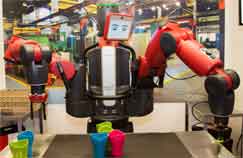The changes to the US tax code in December – lowering rates for many companies, as well as increasing and decreasing deduction timing in several areas– seems to be buoying the US economy, and certainly the stock market.
Less obvious is how those changes may impact business decisions, especially in the manufacturing sector.
Supply Chain Digest Says... |
|
|
First, a summary of the major changes in the tax law as it pertains to business, as provided recently by the Council of Foreign Relations:
It cuts the corporate rate: The rate for C corporations is reduced from 35% to 21%.
It largely ends the taxation of foreign profits: The bill shifts the United States from a worldwide taxation regime, in which US companies are taxed on their global income, to a territorial system, in which earnings abroad are exempted, though the legislation introduces a minimum tax on some forms of foreign income. This aligns the US more closely with other developed countries, most of which operate under a territorial system. The plan also imposes a one-time repatriation tax of up to 15% on companies' currently tax-deferred foreign profits, versus thebtax rate previously.
It gives pass-through businesses a large deduction: The legislation allows owners of certain pass-through firms to deduct 20% of their income. Most US businesses are pass-throughs, in which owners are taxed at individual rates, which are generally much higher than the new corporate rate.
It allows for immediate expensing of capital expenditures: The legislation allows for the full up-front cost of capital investments to be deducted; the previous system required such deductions to be spaced out over several years. Some experts believe this will spur business investment – though many research expenses now have to be deducted over several years.
In general, many believe overall the tax changes will bolster the attractiveness of keeping manufacturing in the US or bringing some portion of manufacturing activity back from offshore. Many of the provisions have been on the National Association of Manufacturers (NAM) wish list for years.
"Companies are dusting off once-shelved plans, re-evaluating existing projects and exploring new investment in factories and equipment," the Wall Street Journal recently wrote.
However, there are a couple of other impacts of the tax changes that are worth noting.
First, some are predicting that the $10,000 cap on the federal deductions taxpayers can take for state and local taxes will make low-tax states, especially in the South, more attractive for workers and businesses, including manufacturers.
(Article Continued Below)
|
CATEGORY SPONSOR: SOFTEON |
|
|
| |
|
|
While southern states have been drawing people and businesses from northern states for years, the fear in the North is that this trend will now accelerate.
 Perhaps more consequentially, the new law may actually accelerate the adoption of robots on the factory floor. As mentioned above, for the next five years, the new tax rules allow companies to immediately deduct the entire cost of equipment purchases from their taxable income. Before, those types of investment had to be depreciated over time. Perhaps more consequentially, the new law may actually accelerate the adoption of robots on the factory floor. As mentioned above, for the next five years, the new tax rules allow companies to immediately deduct the entire cost of equipment purchases from their taxable income. Before, those types of investment had to be depreciated over time.
The change is encouraging manufacturers to replace or add equipment – including robots – because the ROI from the investment is improved.
"We probably would have put it off another year" without the tax incentives, Ken Mathas, president of Cornell Forge Co., a Chicago maker of gears and other components for heavy machinery, told the Wall Street Journal. Mathas said he plans to spend at least $1.5 million this year to add three or more robots to a production line, in part because of a challenge in finding workers and now a higher return on the investment.
Business investment was already strong in the US, with spending on equipment up at a 11.4% annual pace in Q4, the largest gain in three years, according to the Commerce Department.
Do you think the tax changes will have an impact on US manufacturing? How so? Let us know your thoughts at the Feedback section below.
Your Comments/Feedback
|